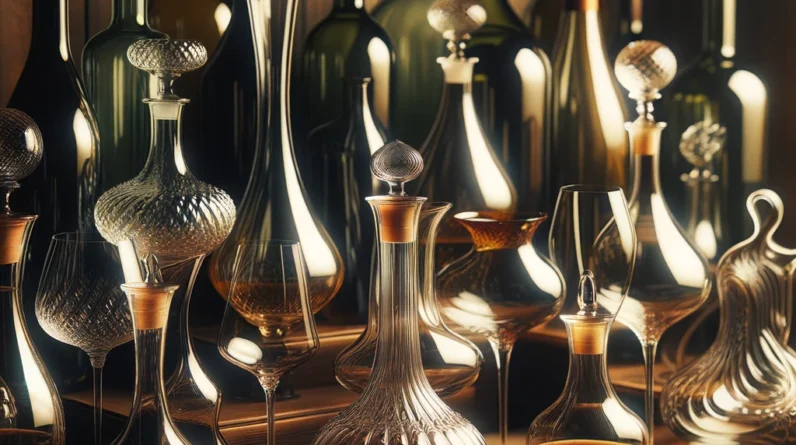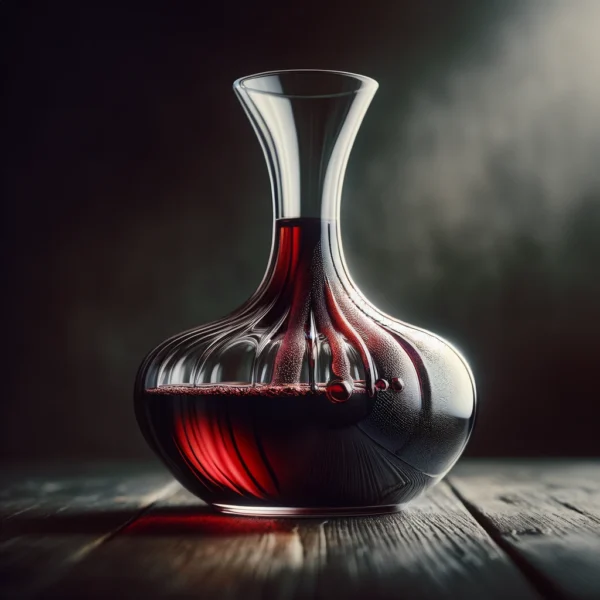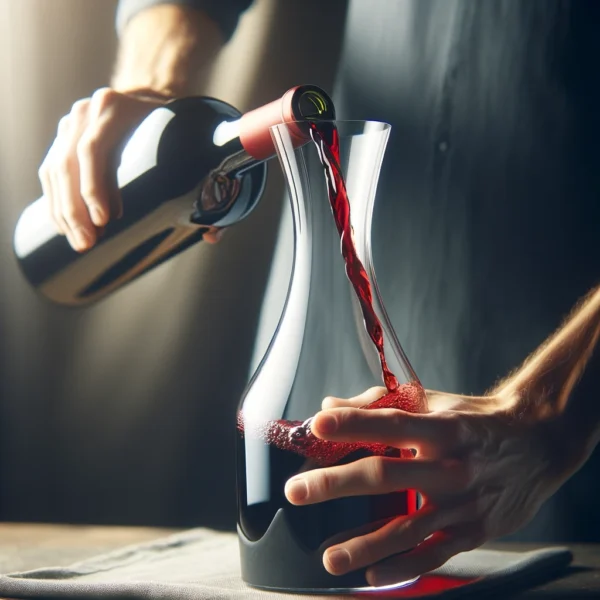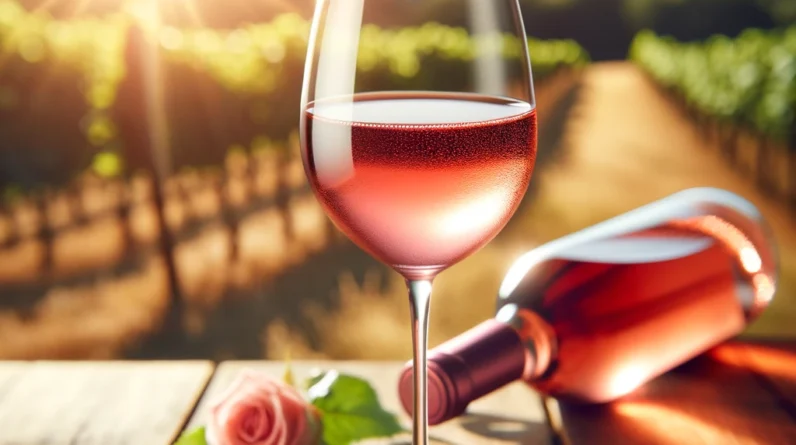
The Art and Science of Decanting Wine: Enhancing Every Sip
Welcome to the world of wine, where every detail matters and every process enhances your experience.
Decanting wine, a practice both ancient and vital, promises to elevate your wine-drinking moments from ordinary to extraordinary.
Whether you’re new to the wine scene or a seasoned enthusiast, understanding the nuances of decanting can transform your appreciation for this beloved beverage.
Let’s uncork the essence of decanting, making it accessible and enjoyable for all.
What is Decanting?
Decanting wine is like giving it a new lease on life.
It’s a tradition as old as wine itself, yet it remains a crucial step for modern wine lovers.
At its heart, decanting is a simple act.
You carefully pour the wine from its original bottle into a different container.
But this simple act can transform your wine drinking experience.

Why Decant?
For Clarity and Purity
Wine, with its rich history and complex character, often carries a hidden companion — sediment.
This sediment, a natural byproduct of the aging process, particularly in red wines and bottles left to age for years, can detract from the wine’s smoothness and clarity.
Imagine pouring a glass of your favorite vintage, only to find gritty particles at the bottom of your glass. Not the experience you were looking for, right?
This is where decanting steps into the spotlight. It’s a guardian of your wine’s purity and elegance.
By transferring the wine from the bottle to a decanter, you’re effectively leaving the sediment behind, trapped in the bottle.
The result? Each glass poured from the decanter is not just clear but also pure, offering a seamless sip from start to finish.
It’s about ensuring that every glass of wine you drink is as perfect as it was intended to be, free from the unwanted texture and taste of sediment.
For Enhanced Flavor and Aroma
Wine is more than just a beverage; it’s an experience, a journey through flavors and aromas that tell the story of its origins, its grapes, and its time in the barrel.
But to truly unlock this story, wine needs to breathe.
Decanting is like opening the door to a treasure trove of sensory delights.
When wine meets air, something magical happens.
The oxygen interacts with the wine, softening the bite of young, harsh tannins and rounding out the flavor profile.
This process, known as aeration, brings forward the wine’s underlying characteristics — the subtle notes of fruit, spice, earth, and wood that were waiting beneath the surface.
Moreover, decanting invites the wine’s aromas to unfurl.
What was once a tightly bound bouquet of scents expands, offering a richer, more complex olfactory experience.
From the initial floral hints to the deeper, more intricate scents that follow, decanting ensures that each sniff and sip is a journey of discovery.
In essence, decanting nurtures the wine’s evolution, accelerating its development to reveal the full spectrum of flavors and aromas.
This process doesn’t just enhance the wine; it transforms it into a more expressive, more captivating version of itself.
It’s an essential step for anyone looking to dive deeper into the wine they’re drinking, to explore beyond the surface and into the heart of the wine’s story.

How to Decant: A Step-by-Step Guide
Prepare the Wine
Before you even think about pouring, give your wine a little rest.
Place the bottle upright and let it stand still for at least 24 hours.
This isn’t just about patience; it’s about precision.
Over time, the sediment in the wine, those tiny particles that have traveled through aging, will make their way to the bottom of the bottle.
This simple step sets the stage for a smoother decanting process, ensuring that when you’re ready to pour, the sediment stays put, and only the clear, refined wine flows.
Choose Your Decanter
Selecting the right decanter is like choosing the perfect outfit for a special occasion; it can enhance the overall experience.
You’re looking for a clean vessel with a wide bottom.
Why wide? Because the wider the base, the more wine comes into contact with air, maximizing aeration.
While any clean container can technically do the job, wine decanters are specially designed for this purpose.
They’re not just functional; they’re sculptural, crafted to both aerate the wine effectively and add an element of elegance to your table setting.
Decant Gradually
Now, the dance begins. Start pouring the wine slowly and steadily into the decanter.
This isn’t a race; it’s a ritual. As you pour, keep an eye on the neck of the bottle.
When you start to see the sediment creep up, approaching the bottle’s neck, it’s time to stop.
You might find it helpful to have a light source behind the bottle—this illuminates the wine, allowing you to see the sediment more clearly and decide when it’s time to halt the pour.
This careful, gradual decanting ensures that the sediment stays in the bottle and out of your decanter and glass.
Let it Breathe
You’ve decanted, but you’re not done yet. Now, give your wine some space to breathe.
This resting phase is when the magic of aeration happens.
For younger wines, a brief pause of around 15 minutes might be enough to open up their flavors and soften their tannins.
Older vintages, with their more delicate structures, might benefit from a longer breathing period, up to several hours, to fully develop their bouquet and taste.
This step is all about patience; giving your wine time to breathe ensures that when you finally taste it, you’re experiencing it at its very best.
By following these steps, you’re not just serving wine; you’re unveiling its full potential.
Each phase, from preparation to presentation, is a testament to the care and respect for the wine’s journey from vineyard to glass.

Choosing the Right Decanter
Decanters are like the wardrobe of the wine world.
They come in an array of shapes and sizes, each with its own unique function and flair.
When choosing a decanter, it’s a blend of personal style meeting practical use.
Here’s how to navigate this choice with ease and insight.
Shapes and Sizes Matter
The shape of a decanter isn’t just about looking good on your dinner table (although that’s a nice bonus).
Each shape serves a specific purpose in the wine’s journey to your glass.
For instance, a decanter with a wide base isn’t just making a style statement.
That broad foundation allows more wine to touch the air, speeding up the oxygenation process.
This means your wine gets to breathe more deeply, awakening its flavors and aromas more fully.
Functionality Leads the Way
While it’s tempting to pick the most striking decanter, functionality should be your compass.
A decanter’s job is twofold: to separate wine from any sediment and to let the wine breathe.
A wide base decanter excels at both.
It offers a smooth platform for catching sediment while ensuring the wine interacts with oxygen more efficiently.
This interaction is crucial for unlocking the wine’s full palette of flavors and softening the bite of tannins, those naturally occurring compounds in wine that can give it a dry or astringent taste.
The Ideal Choice: Wide Base Decanter
So, why lean towards a wide base decanter?
Because it’s all about giving your wine the space it needs to express itself.
The wider the base, the more surface area of the wine is exposed to air.
This exposure is key to enhancing the wine’s aromatic profile—those delightful scents that precede every sip—and softening its tannins for a smoother drinking experience.
Think of it as letting the wine stretch its legs after being cooped up in a bottle for so long.
In the end, choosing a decanter blends personal aesthetics with the science of wine enjoyment.
A wide base decanter is not just a functional tool; it’s a gateway to elevating your wine experience, ensuring each pour is as flavorful and fragrant as it was meant to be.
So, as you select your next decanter, remember that its shape and size are more than just design choices—they’re the keys to unlocking your wine’s hidden treasures.

When to Decant
Young Wines: A Breath of Fresh Air
When it comes to young wines, think of decanting as their introduction to the world.
These wines, often vibrant and spirited, come packed with tannins.
Tannins are natural compounds that can give wine a certain dryness or bitterness.
While they’re a sign of a wine’s potential to age gracefully, in young wines, they can be a bit overwhelming.
Decanting comes to the rescue by softening these tannins, making the wine smoother and more pleasant to drink.
But decanting does more than just tame tannins; it opens up the wine’s flavor profile.
Like lifting the lid off a pot of simmering spices, decanting allows the wine’s rich array of flavors to come forward.
Whether it’s the bright fruitiness of a young red or the crisp, floral notes of a white, an hour or so of decanting lets these characteristics shine through.
It’s like giving the wine a quick aging boost, bringing out depths of flavor that would normally take years to develop.
Aged Wines: Handling With Care
Aged wines are the wise elders of the wine world.
They’ve spent years, perhaps decades, evolving into complex, nuanced beverages.
Over this time, sediment often forms. This sediment isn’t harmful, but it can make the wine less enjoyable to drink, adding an unwanted gritty texture.
Decanting aged wines is primarily about removing this sediment, ensuring a smooth, clean sip every time.
However, aged wines require a gentle touch.
Their aromas and flavors are delicate treasures, the result of years of slow transformation.
Too much exposure to air can scatter these aromas to the winds, leaving the wine less vibrant.
That’s why, with older wines, decanting is a delicate balancing act.
You want to remove the sediment but preserve the wine’s intricate bouquet.
Pouring the wine gently into a decanter and serving it within 30 minutes strikes this balance perfectly, offering a taste of the wine’s refined elegance without losing its ephemeral aromas.
In sum, whether dealing with the youthful energy of new wines or the dignified grace of aged vintages, decanting plays a crucial role.
It’s about understanding the character of the wine in your care and using decanting to bring out its best qualities.
For young wines, a longer decant breathes life into their flavors and softens their tannins.
For aged wines, a brief and careful decant ensures clarity and purity, preserving their delicate flavors for the moment of tasting.
Decanting wine is not just for the connoisseurs; it’s a simple, yet profound, way to enhance your wine experience.
Whether you’re looking to clarify, enrich, or simply explore the depths of your favorite wines, decanting is a skill worth mastering.
So next time you open a bottle, consider decanting.
You may discover flavors and aromas you never knew existed, making every sip a journey worth savoring.
Cheers to your enhanced wine adventures!
FAQs:
Q: Why should I decant wine?
A: Decanting serves two main purposes: it removes sediment from older wines, ensuring a smooth, clear pour, and it aerates the wine, allowing it to breathe.
This enhances the wine’s flavors and aromas, making for a more enjoyable drinking experience.
Q: How long should I decant wine?
A: The duration depends on the wine’s age and type.
Young wines benefit from an hour or so of decanting to soften tannins and open up flavors.
Aged wines need less time, usually about 30 minutes, to avoid losing their delicate bouquet.
Q: Can decanting improve any wine?
A: While not every wine needs decanting, most can benefit from it.
Decanting is especially beneficial for red wines with bold flavors and high tannins, as well as older wines that may have developed sediment.
Q: Do I need a special decanter to decant wine?
A: Any clean, wide-bottomed vessel can act as a decanter.
However, decanters designed for wine, with a wide base to increase surface area exposure to air, are ideal for effectively enhancing the wine’s aroma and flavor.
Q: How do I know when to stop decanting to avoid sediment?
A: When decanting to remove sediment, pour the wine slowly and watch the neck of the bottle.
Stop pouring when you start to see sediment approach the bottle’s neck.
Using a light source behind the bottle can help you see the sediment more clearly.
Q: Can I decant white wine or champagne?
A: Yes, you can decant white wine and champagne, although it’s less common.
Decanting can enhance the flavors and aromas of full-bodied white wines.
For champagne, decanting is more about making a visual statement and may slightly alter the bubbly texture.
Q: How do I clean my decanter after use?
A: Rinse the decanter with warm water immediately after use to prevent staining.
For tough stains, fill the decanter with a mixture of warm water and a small amount of vinegar or baking soda, let it sit, then rinse thoroughly.
Special decanter cleaning brushes can help reach into the bottom.
Q: Is it possible to over-decant wine?
A: Yes, especially with older, more delicate wines.
Over-decanting can lead to the dissipation of subtle aromas and flavors.
It’s important to monitor the wine and taste periodically during decanting to ensure it’s not exposed to air for too long.
Q: Should sediment in wine be a cause for concern?
A: Not at all. Sediment is a natural byproduct of the aging process in wine and is not harmful.
However, it can affect the texture and clarity of the wine, which is why decanting to remove sediment is recommended for a better tasting experience.
By understanding these aspects of decanting, you can enhance your wine drinking experience, making each glass more enjoyable and expressive of the wine’s true character.







